|
|
|
Sort Order |
|
|
|
Items / Page
|
|
|
|
|
|
|
| Srl | Item |
| 1 |
ID:
149008


|
|
|
|
|
| Summary/Abstract |
Combined external-internal flow simulation is required for the estimation of aerodynamic forces and moments of high speed air-breathing vehicle design. A wingless, X-tail configuration with asymmetrically placed rectangular air intake is numerically explored for which experimental data is available for different angles of attack. The asymmetrically placed air intakes and protrusions make the flow field highly three-dimensional and existing empirical relations are inadequate for preliminary design. Three dimensional Navier Stokes equations along with SST-kω turbulence model were solved with a commercial CFD solver to analyse the combined external and internal flow field of the configuration at different angles of attack. Estimated aerodynamic coefficients match well with experimental data and estimated drag coefficient are within 8.5 per cent of experimental data. Intake performance parameters were also evaluated for different angles of attack.
|
|
|
|
|
|
|
|
|
|
|
|
|
|
|
|
| 2 |
ID:
149007
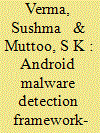

|
|
|
|
|
| Summary/Abstract |
With an exponential growth in smartphone applications targeting useful services such as banks, healthcare, m-commerce, security has become a primary concern. The applications downloaded from unofficial sources pose a security threat as they lack mechanisms for validation of the applications. The malware infected applications may lead to several threats such as leaking user’s private information, enforcing malicious deductions for sending premium SMS, getting root privilege of the android system and so on. Existing anti-viruses depend on signature databases that need to be updated from time to time and are unable to detect zero-day malware. The Android Operating system allows inter-application communication through the use of component reuse by using intents. Unfortunately, message passing is also an application attack surface. A hybrid method for android malware detection by analysing the permissions and intent-filters of the manifest files of the applications is presented. A malware detection framework is developed based on machine learning algorithms and on the basis of the decision tree obtained from ID3 and J48 classifiers available in WEKA. Both algorithms gave same results with an error percentage of 6 per cent. The system improves detection of zero day malware.
|
|
|
|
|
|
|
|
|
|
|
|
|
|
|
|
| 3 |
ID:
148998


|
|
|
|
|
| Summary/Abstract |
As computer networks are emerging in everyday life, network security has become an important issue. Simultaneously, attacks are becoming more sophisticated, making the defense of computer networks increasingly difficult. Attack graph is a modeling tool used in the assessment of security of enterprise networks. Since its introduction a considerable amount of research effort has been spent in the development of theory and practices around the idea of attack graph. This paper presents a consolidated view of major attack graph generation and analysis techniques.
|
|
|
|
|
|
|
|
|
|
|
|
|
|
|
|
| 4 |
ID:
149003


|
|
|
|
|
| Summary/Abstract |
Encryption using vector decomposition problem (VDP) on higher dimensional vector spaces is a novel method in cryptography. Yoshida has shown that the VDP on a two-dimensional vector space is at least as hard as the computational Diffie-Hellman problem on a one-dimensional subspace under certain conditions. Steven Galbraith has shown that for certain curves, the VDP is at most as hard as the discrete logarithm problem on a one-dimensional subspace. Okomoto and Takashima proposed encryption scheme and signature schemes using VDP. An authenticated key agreement scheme using vector decomposition problem is proposed in this paper
|
|
|
|
|
|
|
|
|
|
|
|
|
|
|
|
| 5 |
ID:
149004
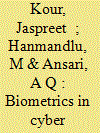

|
|
|
|
|
| Summary/Abstract |
Computers play an important role in our daily lives and its usage has grown manifolds today. With ever increasing demand of security regulations all over the world and large number of services provided using the internet in day to day life, the assurance of security associated with such services has become a crucial issue. Biometrics is a key to the future of data/cyber security. This paper presents a biometric recognition system which can be embedded in any system involving access control, e-commerce, online banking, computer login etc. to enhance the security. Fingerprint is an old and mature technology which has been used in this work as biometric trait. In this paper a fingerprint recognition system based on no minutiae features: Fuzzy features and Invariant moment features has been developed. Fingerprint images from FVC2002 are used for experimentation. The images are enhanced for improving the quality and a region of interest (ROI) is cropped around the core point. Two sets of features are extracted from ROI and support vector machine (SVM) is used for verification. An accuracy of 95 per cent is achieved with the invariant moment features using RBF kernel in SVM.
|
|
|
|
|
|
|
|
|
|
|
|
|
|
|
|
| 6 |
ID:
149012
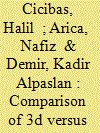

|
|
|
|
|
| Summary/Abstract |
This research compares 3D versus 4D (three spatial dimensions and the time dimension) multi-objective and multi-criteria path-planning for unmanned aerial vehicles in complex dynamic environments. In this study, we empirically analyse the performances of 3D and 4D path planning approaches. Using the empirical data, we show that the 4D approach is superior over the 3D approach especially in complex dynamic environments. The research model consisting of flight objectives and criteria is developed based on interviews with an experienced military UAV pilot and mission planner to establish realism and relevancy in unmanned aerial vehicle flight planning. Furthermore, this study incorporates one of the most comprehensive set of criteria identified during our literature search. The simulation results clearly show that the 4D path planning approach is able to provide solutions in complex dynamic environments in which the 3D approach could not find a solution.
|
|
|
|
|
|
|
|
|
|
|
|
|
|
|
|
| 7 |
ID:
149001
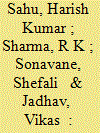

|
|
|
|
|
| Summary/Abstract |
International data encryption algorithm (IDEA) is a secret key or symmetric key block cipher. The purpose of IDEA was to replace data encryption standard (DES) cipher, which became practically insecure due to its small key size of 56 bits and increase in computational power of systems. IDEA cipher mainly to provide data confidentiality in variety of applications such as commercial and financial application e.g. pretty good privacy (PGP) protocol. Till 2015, no successful linear or algebraic weaknesses IDEA of have been reported. In this paper, author explained IDEA cipher, its application in PGP and did a systematic survey of various attacks attempted on IDEA cipher. The best cryptanalysis result which applied to all keys could break IDEA up to 6 rounds out of 8.5 rounds of the full IDEA cipher1. But the attack requires 264 known plaintexts and 2126.8 operations for reduced round version. This attack is practically not feasible due to above mention mammoth data and time requirements. So IDEA cipher is still completely secure for practical usage. PGP v2.0 uses IDEA cipher in place of BassOmatic which was found to be insecure for providing data confidentiality.
|
|
|
|
|
|
|
|
|
|
|
|
|
|
|
|
| 8 |
ID:
149010


|
|
|
|
|
| Summary/Abstract |
The development of physics based analysis to predict the hover performance of a micro rotor system meant for a hover capable micro air vehicle for studying the role of blade geometric parameters (such as planform, twist etc.) is discussed. The analysis is developed using blade element theory using lookup table for the sectional airfoil properties taken from literature. The rotor induced inflow is obtained using blade element momentum theory. The use of taper seems beneficial in improving the hover efficiency for lower values of thrust coefficient. For rotors operating at high thrust conditions, high negative twist is desirable. There is no unique blade geometry which performs well under all thrust conditions. This well validated analysis can be used for design of hover capable micro air vehicles.
|
|
|
|
|
|
|
|
|
|
|
|
|
|
|
|
| 9 |
ID:
148999


|
|
|
|
|
| Summary/Abstract |
Conventional network routing protocols rely on predefined numerical network unique node ID or group identifier for packet delivery, independent of semantic applications. This compels incorporation of resource/service discovery approaches in the design itself, at higher layers of network, causing additional overhead. This overhead, though tolerable in high speed wired networks, significantly restricts the performance in the infrastructure-less wireless ad hoc networks expending their limited battery resources, which are already consumed due to assigning unique identifiers to the naturally anonymous and high mobile nodes. This study proposes a single routing approach which facilitates descriptive and semantically-rich identification of network’s resources/services. This fusion of the discovery processes of the resources and the path based on their similarity in a single phase significantly reduces traffic load and latency of communication considering the generality too. Further, a framework capable of exploiting application-specific semantics of messages, adaptable to diverse traffic patterns is proposed. Analytical results amply illustrate the scalability and efficacy of the proposed method.
|
|
|
|
|
|
|
|
|
|
|
|
|
|
|
|
| 10 |
ID:
149011
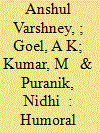

|
|
|
|
|
| Summary/Abstract |
Anthrax, caused by Bacillus anthracis is known to occur globally since antiquity. Besides being an important biothreat agent, it is an important public health importance pathogen also in countries like India. B. anthracis secretes three distinct toxins, namely protective antigen (PA), lethal factor (LF) and edema factor (EF). PA is the central moiety of the anthrax toxin complex and therefore has been a molecule of choice for vaccine development. PA has four different domains with different functions. In this study, the major domains of PA were cloned and expressed in bacterial system. The purified recombinant proteins were used to determine the humoral immune response by ELISA using 43 human cutaneous anthrax serum samples. The maximum immunoreactivity was observed with the whole PA protein followed by domain 2, 4 and 1. The study corroborated that in addition to full PA, individual domain 2 and 4 can also be good target for vaccine development as well as for serodiagnostic assays for cutaneous anthrax
|
|
|
|
|
|
|
|
|
|
|
|
|
|
|
|
| 11 |
ID:
149002


|
|
|
|
|
| Summary/Abstract |
Public key cryptosystems are secure only when the authenticity of the public key is assured. Shao proposed
a new scheme to overcome the problems of the existing schemes, which suffers from two major drawbacks. The
first drawback is the availability of users’ passwords in plaintext format in key server which are prone to attacks
by ill-minded users. The second one is depending on the key server blindly for certificate generation, without
further verification by the user. To overcome these severe drawbacks, we proposed an improved key authentication
scheme based on Chinese remainder theorem and discrete logarithms. Our scheme allows the user to generate his/
her certificate without the help of any trusted third party. This scheme is intended for online services, military and
defense applications to exchange keys securely.
|
|
|
|
|
|
|
|
|
|
|
|
|
|
|
|
| 12 |
ID:
149009


|
|
|
|
|
| Summary/Abstract |
Modern control law designs increasingly use aircraft attitude information to improve aircraft manoeuverability. Attitude information allows for gravity term compensations in the longitudinal as well as lateral directional control laws of a typical fighter aircraft. Methodologies and comparisons of multiplicative error state Kalman filter (MEKF) and nonlinear complimentary filter for estimation of attitudes of a high performance aircraft using its onboard autonomous sensors is presented. Shows a problem in pitch angle estimation beyond ± 80 deg in the MEKF and a solution is proposed for the same for the first time. Also presents novel aiding sensor modelling for the implementation of attitude heading reference system for this class of aircraft for the first time. The filter formulations are evaluated using full range manuoevering real flight test data.
|
|
|
|
|
|
|
|
|
|
|
|
|
|
|
|
| 13 |
ID:
149013


|
|
|
|
|
| Summary/Abstract |
A neuro-fuzzy based improved internal model control (I-IMC) is proposed for speed control of uncertain nonlinear heavy duty vehicle (HDV) as the standard IMC (S-IMC) can’t tackle the nonlinear systems effectively and degrades the performance of HDV system. Adaptive neuro-fuzzy inference system and artificial neural network with adaptive control are used for the design of I-IMC. The proposed control techniques are developed to achieve the better speed tracking performance and robustness of HDV system under the influence of road grade disturbance.
|
|
|
|
|
|
|
|
|
|
|
|
|
|
|
|
| 14 |
ID:
149005
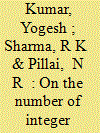

|
|
|
|
|
| Summary/Abstract |
This paper presents the number of k-stage integer recurrence relations (IRR) over the ring Z2 which generates sequences of maximum possible period (2k-1)2e-1 for e>1. This number corresponds to the primitive polynomials mod 2 which satisfy the condition proposed by Brent and is2(e-2)k+1(2k-1-1) for e>3. This number is same as measured by Dai but arrived at with a different condition for maximum period. Our way of counting gives an explicit method for construction of such polynomials. Furthermore, this paper also presents the number of different sequences corresponding to such IRRs of maximum period.
|
|
|
|
|
|
|
|
|
|
|
|
|
|
|
|
| 15 |
ID:
149000


|
|
|
|
|
| Summary/Abstract |
Steganography is primarily used for the covert transmission of information even though the purpose can be legitimate or malicious. The primary purpose of this work is to build a firewall which will thwart this transmission. This will be achieved by radiometric and geometric operations. These operations will degrade the quality of cover image. However these can be restored to some extent by a deconvolution operation. The finally deconvolved image is subjected to steganalysis to verify the absence of stego content. Experimental results showed that PSNR and SSIM values are between 35 dB - 45 dB and 0.96, respectively which are above the acceptable range. Our method can suppress the stego content to large extent irrespective of embedding algorithm in spatial and transform domain. We verified by using RS steganalysis, difference image histogram and chi-square attack, that 95 per cent of the stego content embedded in the spatial domain was removed by our showering techniques. We also verified that 100 per cent of the stego content was removed in the transform domain with PSNR 30 dB - 45 dB and SSIM between 0.67-0.99. Percentage of stego removed in both domains was measured by using bit error rate and first order Markov feature.
|
|
|
|
|
|
|
|
|
|
|
|
|
|
|
|
| 16 |
ID:
149006


|
|
|
|
|
| Summary/Abstract |
Immense growth in network-based services had resulted in the upsurge of internet users, security threats and cyber-attacks. Intrusion detection systems (IDSs) have become an essential component of any network architecture, in order to secure an IT infrastructure from the malicious activities of the intruders. An efficient IDS should be able to detect, identify and track the malicious attempts made by the intruders. With many IDSs available in the literature, the most common challenge due to voluminous network traffic patterns is the curse of dimensionality. This scenario emphasizes the importance of feature selection algorithm, which can identify the relevant features and ignore the rest without any information loss. In this paper, a novel rough set κ-Helly property technique (RSKHT) feature selection algorithm had been proposed to identify the key features for network IDSs. Experiments carried using benchmark KDD cup 1999 dataset were found to be promising, when compared with the existing feature selection algorithms with respect to reduct size, classifier’s performance and time complexity. RSKHT was found to be computationally attractive and flexible for massive datasets.
|
|
|
|
|
|
|
|
|
|
|
|
|
|
|
|
| 17 |
ID:
148997


|
|
|
|
|
| Summary/Abstract |
In the present cyber age, public services are getting more and more dependent on use of Information and communication technologies (ICT) day by day. A number of applications viz., Internet of Things, PDF, cloud computing and virtualization and machine to machine (M2M) system usage are sneaking deeply into our everyday life. The more we depend on ICT, the more deepens our concern about IT security or cyber security. Cyber security protects the data and integrity of assets that belong to or connect to a network. It is meant to defend those assets against all sorts of threat actors throughout the life cycle of a cyber attack. It is quite unsurprising that cyber security industry is growing at the same pace as ICT is doing.
|
|
|
|
|
|
|
|
|
|
|
|
|
|
|
|
|
|
|
|
|